Let’s not mince any words: Nintendo hasn’t done right by Samus Aran in seven years.
Forget about Smash Bros. — which had a completely different set of issues with accurately representing Nintendo’s first lady of gaming — because that wasn’t a proper Metroid game. And forget about Metroid: Federation Force, because that was barely a game at all.
The last real Metroid game — the last real game to make good on Metroid’s mandate of exploration, adventure, and meaningful, methodical combat — was Metroid: Other M. For all it faults — and there were many faults — at least it was a Metroid game. And after seven years, I’m prepared to take any Metroid game over nothing.
So thank all that is good and holy for Nintendo’s and MercurySteam’s Metroid: Samus Returns.
Samus Aran is back — and so is Metroid
As one can probably infer, Metroid: Samus Returns is a Nintendo 3DS remake of the 1991 Game Boy title Metroid II: Return of Samus. The games feature the same plot, the same exploration elements and more-or-less the same gameplay mechanics. Is Samus Returns a marked improvement — a necessary remake that redefines the genre, the franchise and the character? No, not really.
It is, however, a much-needed return to form for the character and the franchise, so the fact that Samus Returns looks like a real Metroid game, feels like a real Metroid game and plays like a real Metroid game is indicative of the highest praise that one can bestow upon the title. In more than a few ways, Samus Returns is a throwback to a bygone era of game design and video game storytelling. The game opens with hand-drawn artwork and several paragraphs of text to bring players up-to-speed.
In more than a few ways, Samus Returns is a throwback to a bygone era of game design and video game storytelling. The game opens with hand-drawn artwork and several paragraphs of text to bring players up-to-speed.
Samus ruined the Space Pirates plan to use Metroids to take over the galaxy, and the Galactic Federation has sent several teams to planet SR388 — home of the Metroids — to exterminate the species, but the teams have all disappeared, so the Galactic Federation has decided to send famed bounty hunter Samus Aran to figure out what happened and also exterminate the Metroids.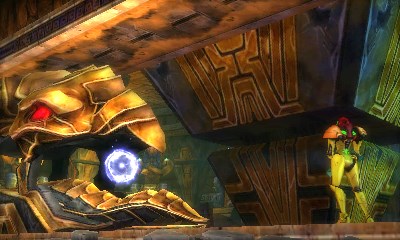 Look, this is a remake of a 1991 Game Boy title.
Look, this is a remake of a 1991 Game Boy title.
There are no extensive cutscenes, there are no deep moral or narratological quandaries to power through, there are no poorly developed minority characters thrown into an equally underdeveloped story by developers trying and failing to correct years of internalized prejudice by the video game industry.
The plot of Samus Returns barely matters. All that matters is that you know who you’re playing as, which direction you need to travel in, who to shoot and how to shoot them — all issues addressed within the game’s first five minutes.
Shoot-em-up, but also take your time and relish the atmosphere
There’s a noticeable fluidity to the combat mechanics in Samus Returns that’s quite unlike any of the previous side-scrolling titles in the franchise. Excluding the first-person Metroid Prime games, the Metroid franchise has always defined itself by side-scrolling platforming, with some healthy energy-blasting thrown into the mix.
Samus Returns capitalizes on the series’ side-scrolling, platforming mechanics, and changes up the energy-blasting by giving users complete 360-degree control over Samus’s arm cannon. You can shoot to the left, to the right, up, down, as well as every every angle in-between. You’ve also got a melee move that you only really need when you’re trying to counter enemy attacks.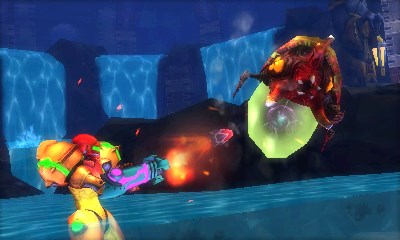 Now, a brief digression to address the elephant in the room. Yes, Metroid: Samus Returns is not technically a full-fledged Nintendo title. Spanish studio MercurySteam — responsible for the Castlevania: Lords of Shadow titles, and 2013’s horrifically named Castlevania: Lords of Shadow — Mirror of Fate spin-off for the 3DS — did most of the heavy-lifting, with collaboration from Nintendo. The game’s directors are Jose Luis Marquez, as well as Takehiko Hosokawa, with Metroid grandfather Yoshio Sakamoto acting as producer. All of this is to say that a lot of the modernization that’s present in Samus Returns is no doubt a result of MercurySteam’s inclusion.
Now, a brief digression to address the elephant in the room. Yes, Metroid: Samus Returns is not technically a full-fledged Nintendo title. Spanish studio MercurySteam — responsible for the Castlevania: Lords of Shadow titles, and 2013’s horrifically named Castlevania: Lords of Shadow — Mirror of Fate spin-off for the 3DS — did most of the heavy-lifting, with collaboration from Nintendo. The game’s directors are Jose Luis Marquez, as well as Takehiko Hosokawa, with Metroid grandfather Yoshio Sakamoto acting as producer. All of this is to say that a lot of the modernization that’s present in Samus Returns is no doubt a result of MercurySteam’s inclusion.
For those critical of the Spanish studio’s previous efforts, there’s quite a bit of good news. MercurySteam’s work on Samus Returns draws on the franchise’s storied history, while also bringing the title into the modern age. The aforementioned melee countermove, for example, feels a bit like a quick time event, but whereas QTE’s have a tendency to break up gameplay flow, the counters in Samus Returns feel fluid and natural.
An enemy attacks, you time a counter, and then you blast the everloving snot out of it with your arm cannon. The whole process takes seconds to execute and doesn’t slow down Samus at all. Still, this is a proper Metroid game, which means that the series’ core exploration elements — indeed, the Metroid in the ‘Metroidvania‘ demonym used to describe games that combine exploration, side-scrolling, platforming, and action-adventure elements from the Metroid and Castlevania games — are more than present. All of which is to say that if you make the right choice of playing Samus Returns, expect a lot of backtracking. Just like previous Metroid games, Samus Returns is almost explicit in its emphasis on the fact that you’ll only be able to return to certain levels once you get the right upgrades.
Still, this is a proper Metroid game, which means that the series’ core exploration elements — indeed, the Metroid in the ‘Metroidvania‘ demonym used to describe games that combine exploration, side-scrolling, platforming, and action-adventure elements from the Metroid and Castlevania games — are more than present. All of which is to say that if you make the right choice of playing Samus Returns, expect a lot of backtracking. Just like previous Metroid games, Samus Returns is almost explicit in its emphasis on the fact that you’ll only be able to return to certain levels once you get the right upgrades.
If you’re too big to crawl into a compact space, you’ll need to come back when you’ve got the morph ball. You don’t start off with a fully powered arm cannon, which means that you won’t be able to blast through every barrier and access every level. You can’t jump or attack enemies in the morph ball form, meaning you’ll have to backtrack to certain portions of the map to progress. It’s not cruel or manipulative, it’s not petty and it’s not a result of the developers failing to plan out their levels. It’s Metroid, and if there’s one thing Samus Returns does supremely well, it’s being a proper Metroid game.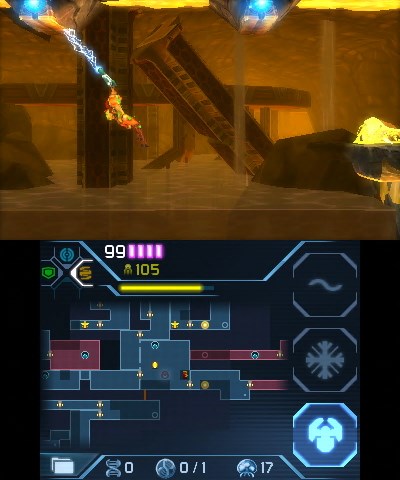 That extends to the game’s overall atmosphere and aesthetic. Deep blues, striking reds and unsettling greens all mix together to create a planet that not only feels alive, but feels worthy of exploring. As for the game’s music, fans will be disappointed to learn that series composer Kenji Yamamato did not return to serve as the game’s lead composer. However, Daisuke Matsuoka — whose previous work on titles like Donkey Kong Country Returns: Tropical Freeze and Tomodachi Life are noteworthy — more than successfully carries on the mantle.
That extends to the game’s overall atmosphere and aesthetic. Deep blues, striking reds and unsettling greens all mix together to create a planet that not only feels alive, but feels worthy of exploring. As for the game’s music, fans will be disappointed to learn that series composer Kenji Yamamato did not return to serve as the game’s lead composer. However, Daisuke Matsuoka — whose previous work on titles like Donkey Kong Country Returns: Tropical Freeze and Tomodachi Life are noteworthy — more than successfully carries on the mantle.
I’ve often compared Metroid’s music to Vangelis’s work on Blade Runner. Metroid’s not as synth-heavy as Blade Runner, but the game’s music feels eerie and ethereal in an unnerving way. When I play a Metroid game, I’m not looking to get scared — I’m looking to feel that exploring a foreign planet riddled with alien lifeforms is an endeavour that warrants caution. Suffice it to say, Matsuoka captures the requisite emotion necessary for exploring a planet where everything is trying to kill you.
Addressing the 3DS of it all
By now, one must have noticed that there’s been very little discussion of how this 3DS Metroid title distinguishes itself from its Game Boy Advance or SNES comrades. Indeed, why precisely did Nintendo need to release a Metroid game on an aging — yet still surprisingly spry — handheld console, instead of something like the Nintendo Switch?
First things first — just like the Castlevania games for the Nintendo DS — Samus Returns makes ample use of the 3DS’s second screen. Outside of letting players quickly switch between different arm cannon upgrades, the second screen also features an extensive level map. You can also edit the map by placing differently coloured icons to indicate items hidden behind blocked walls, the locations of temporarily inaccessible level doors, enemies, as well as level elements that you want to return to and explore further.
Outside of letting players quickly switch between different arm cannon upgrades, the second screen also features an extensive level map. You can also edit the map by placing differently coloured icons to indicate items hidden behind blocked walls, the locations of temporarily inaccessible level doors, enemies, as well as level elements that you want to return to and explore further.
As for the 3DS’s eponymous 3D capability, just like with every other 3DS game, you can turn it off and miss out on little of the action. If you do choose to play Samus Returns in 3D, you’ll be happy to know that the game won’t be privy to any unnecessary lag. The game ran smoothly — without any hiccup — even on my first-generation Nintendo 3DS from 2012. I’d imagine that, with a New Nintendo 3DS, New Nintendo 3DS XL, or New Nintendo 2DS XL, Samus Returns would look and feel as smooth as can be.
On the subject of the newer 3DS consoles, Samus Returns is also compatible with figurines from the Metroid line of Amiibo. If you can find the Metroid Amiibo, you’ll be able to unlock additional in-game content.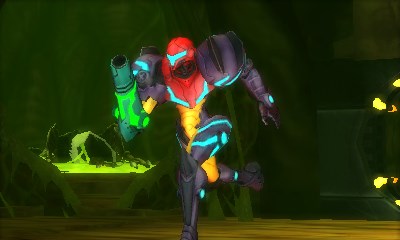 However, these facts do little to address the glaring issue that Samus Returns could just as easily have been released for Nintendo Switch. So why 3DS? Indeed, why 3DS in 2017?
However, these facts do little to address the glaring issue that Samus Returns could just as easily have been released for Nintendo Switch. So why 3DS? Indeed, why 3DS in 2017?
Frankly, I believe it’s a matter of addressing Samus’s sordid treatment at the hands of the Japanese gaming giant. I’ve said twice now that Nintendo hasn’t done right by Samus Aran in seven years. In that time, the video game industry has changed — Nintendo has changed.
I believe that Nintendo chose to release a Metroid game on the 3DS as a show of good faith for all of those scorned fans. More importantly, it costs less to build a 3DS game than a full-powered Switch title, so if it turns out that Nintendo was right to shelve the character for so long — if it turns out that players aren’t interested in Samus Aran outside of Smash Bros. — then the previously announced and presumably still in-development Metroid Prime 4 title can be quietly dealt with in any way that Nintendo sees fit.
Call it a cynical analysis, call it an extreme interpretation, call me uninformed and unaware, but there’s a reason we got a remake instead of a new-from-the-ground-up main series title.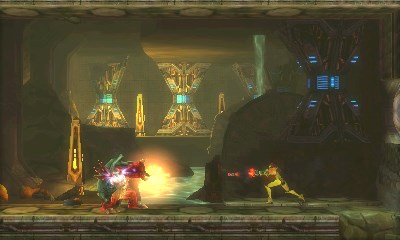 Regardless of what’s next for the Metroid franchise, make no mistake, Samus Returns is a treat and a welcome return-to-form for one of the most important characters in video game history.
Regardless of what’s next for the Metroid franchise, make no mistake, Samus Returns is a treat and a welcome return-to-form for one of the most important characters in video game history.
Nintendo’s queen of cosmic exploration is back. Long may she reign.
MobileSyrup may earn a commission from purchases made via our links, which helps fund the journalism we provide free on our website. These links do not influence our editorial content. Support us here.


